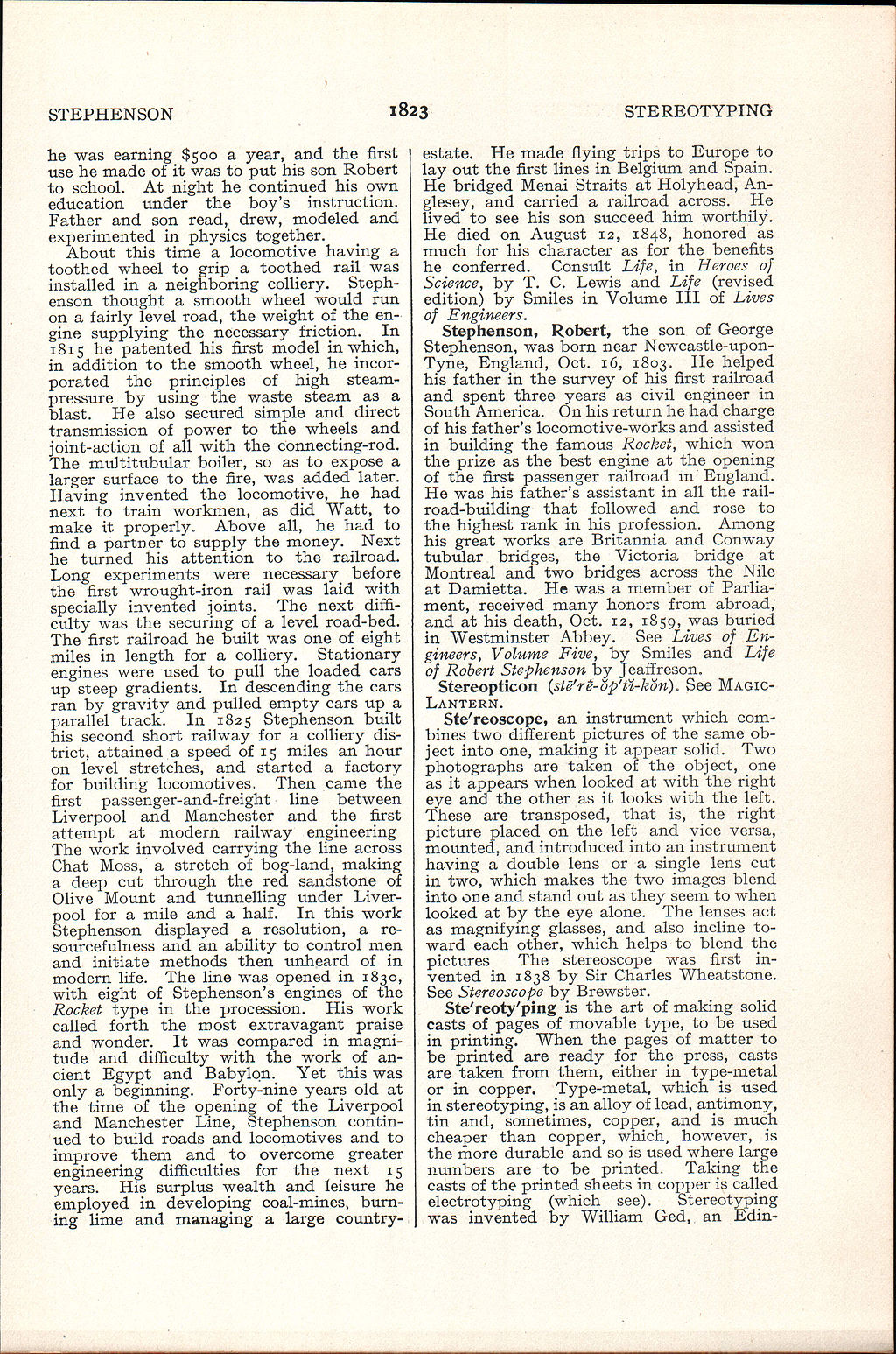STEPHENSON
1823
STEREOTYPING
he was earning $500 a year, and the first use he made of it was to put his son Robert to school. At night he continued his own education under the boy's instruction. Father and son read, drew, modeled and experimented in physics together.
About this time a locomotive haying a toothed wheel to grip a toothed rail was installed in a neighboring colliery. Steph-enson thought a smooth wheel would run on a fairly level road, the weight of the engine supplying the necessary friction. In 1815 he patented his first model in which, in addition to the smooth wheel, he incorporated the principles of high steam-pressure by using the waste steam as a blast. He also secured simple and direct transmission of power to the wheels and joint-action of all with the connecting-rod. The multitubular boiler, so as to expose a larger surface to the fire, was added later. Having invented the locomotive, he had next to train workmen, as did Watt, to make it properly. Above all, he had to find a partner to supply the money. Next he turned his attention to the railroad. Long experiments were necessary before the first wrought-iron rail was laid with specially invented joints. The next difficulty was the securing of a level road-bed. The first railroad he built was one of eight miles in length for a colliery. Stationary engines were used to pull the loaded cars up steep gradients. In descending the cars ran by gravity and pulled empty cars up a parallel track. In 1825 Stephenson built his second, short railway for a colliery district, attained a speed of 15 miles an hour on level stretches, and started a factory for building locomotives, Then came the first passenger-and-freight line between Liverpool and Manchester and the first attempt at modern railway engineering The work involved carrying the line across Chat Moss, a stretch of bog-land, making a deep cut through the red sandstone of Olive Mount and tunnelling under Liverpool for a mile and a half. In this work Stephenson displayed a resolution, a resourcefulness and an ability to control men and initiate methods then unheard of in modern life. The line was opened in 1830, with eight of Stephenson's engines of the Rocket type in the procession. His work called forth the most extravagant praise and wonder. It was compared in magnitude and difficulty with the work of ancient Egypt and Babylon. Yet this was only a beginning. Forty-nine years old at the time of the opening of the Liverpool and Manchester Line, Stephenson continued to build roads and locomotives arid to improve them and to overcome greater engineering difficulties for the next 15 years. His surplus wealth and leisure he employed in developing coal-mines, burning lime and managing a large country-
estate. He made flying trips to Europe to lay out the first lines in Belgium and Spain. He bridged Menai Straits at Holyhead, Anglesey, and carried a railroad across. He lived to see his son succeed him worthily. He died on August 12, 1848, honored as much for his character as for the benefits he conferred. Consult Life, in Heroes of Science, by T. C. Lewis and Life (revised edition) by Smiles in Volume III of Lives of Engineers.
Stephenson, Robert, the son of George Stephenson, was born near Newcastle-upon-Tyne, England, Oct. 16, 1803. He helped his father in the survey of his first railroad and spent three years as civil engineer in South America. On his return he had charge of his father's locomotive-works and assisted in building the famous Rocket, which won the prize as the best engine at the opening of the first passenger railroad in England. He was his father's assistant in all the railroad-building that followed and rose to the highest rank in his profession. Among his great works are Britannia and Conway tubular bridges, the Victoria bridge at Montreal and two bridges across the Nile at Damietta. He was a member of Parliament, received many honors from abroad, and at his death, Oct. 12, 1859, was buried in Westminster Abbey. See Lives of Engineers, Volume Five, by Smiles and Life of Robert Stephenson by Jeaffreson,
Stereopticon (ste're-op'ti-kori)* See MAGIC-LANTERN.
Ste'reoscope, an instrument which combines two different pictures of the same object into one, making it appear solid. Two photographs are taken of the object, one as it appears when looked at with the right eye and the other as it looks with the left. These are transposed, that is, the right picture placed on the left and vice versa, mounted, and introduced into an instrument having a double lens or a single lens cut in two, which makes the two images blend into one and stand out as they seem to when looked at by the eye alone. The lenses act as magnifying glasses, and also incline toward each other, which helps to blend the pictures The stereoscope was first invented in 1838 by Sir Charles Wheatstone. See Stereoscope by Brewster.
Ste'reoty'ping is the art of making solid casts of pages of movable type, to be used in printing. When the pages of matter to be printed are ready for the press, casts are taken from them, either in type-metal or in copper. Type-metal, which is used in stereotyping, is an alloy of lead, antimony, tin and, sometimes, copper, and is much cheaper than copper, which, however, is the more durable and so is used where large numbers are to be printed. Taking the casts of the printed sheets in copper is called electrotyping (which see). Stereotyping was invented by William Ged, an Edin-
